We’ve all heard of solar panels and roofs, wind turbines, and even waves generating electricity, but what about the floors, what good can they do in terms of renewable energy you may ask? Well, a team from the University of Wisconsin-Madison has now discovered a way how to convert footsteps into electricity and the details of which was published in the journal Nano Energy.
The team used wood pulp, which is already used widely in flooring, as the main ingredient. This is because part of pulp is made of cellulose nanofibers and it’s these fibers that produce an electrical charge (after being chemically treated) once they meet any untreated nanofibers. Wood pulp is cheap, readily available, and a renewable waste product so is perfect for this use. This type of operation could easily go large scale and would be relatively inexpensive for firms to set up.

This latest type of operation is dubbed as “roadside energy harvesting” as doesn’t depend on fair weather and could be installed just about anywhere. Places of heavy traffic such as stadiums, malls, and other entertainment facilities, would benefit largely from having this type of system installed and could collectively harvest a significant amount of energy. Once ready for the market, Xudong Wang, associate professor of materials science and engineering at UW-Madison and lead author of the study says that this type of system can be integrated into any flooring once it ready. So, watch this space for you are looking for something a little different to get your renewable energy from.
More News To Read











